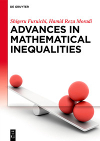- About MAA
- Membership
- MAA Publications
- Periodicals
- Blogs
- MAA Book Series
- MAA Press (an imprint of the AMS)
- MAA Notes
- MAA Reviews
- Mathematical Communication
- Information for Libraries
- Author Resources
- Advertise with MAA
- Meetings
- Competitions
- Programs
- Communities
- MAA Sections
- SIGMAA
- MAA Connect
- Students
- MAA Awards
- Awards Booklets
- Writing Awards
- Teaching Awards
- Service Awards
- Research Awards
- Lecture Awards
- Putnam Competition Individual and Team Winners
- D. E. Shaw Group AMC 8 Awards & Certificates
- Maryam Mirzakhani AMC 10 A Awards & Certificates
- Two Sigma AMC 10 B Awards & Certificates
- Jane Street AMC 12 A Awards & Certificates
- Akamai AMC 12 B Awards & Certificates
- High School Teachers
- News
You are here
Advances in Mathematical Inequalities

Publisher:
De Gruyter
Publication Date:
2020
Number of Pages:
268
Format:
Hardcover
Price:
137.99
ISBN:
978-3-11-064343-5
Category:
Monograph
[Reviewed by , on ]
Allen Stenger
08/30/2020
This is an exposition of recent results in the theory of inequalities. It covers many areas and is something of a hodge-podge, but the authors do attempt to organize it according to broad categories. There is also a very good index, that covers all the named inequalities, the terminology, and the techniques.
The coverage is slanted toward operator inequalities and linear spaces. These generalize the more familiar inequalities on the real numbers; for example, there are recurring generalizations of Young’s inequality and Jensen’s inequality (consequences of convexity), and of results on the familiar means (arithmetic, geometric, harmonic, and sometimes logarithmic). In general, the proof methods are straightforward; the skill comes in deciding what to prove and how much we can prove in these more general contexts.
The book has a lot of coverage of refinements of inequalities with various kinds of scaling factors, often the Specht ratio or the Kantorovich constant. The idea here is that inequalities are usually equalities if the arguments are equal, but we can strengthen the inequality if we use a measure of how unequal the arguments are. The same idea can be used to provide “reverses” of inequalities (some authors call these “converses”): by applying a scaling factor we can reverse the sense of the inequality. For example (Chapter 2), for \( a \), \( b \) positive and \( 0 \leq v \leq 1 \) the original Young inequality is
\( (1-v)a + vb \geq a^{1-v}b^{v}. \)
A refinement using the Specht ratio \( S \) is
\( (1-v)a + vb \geq S((b/a)^{r})a^{1-v}b^{v} \)
where \( r=\min(v, 1-v ) \). A reverse Young inequality is
\( (1-v)a + vb \leq a^{1-v}b^{v} \mbox{exp} \left( \frac{v(1-v)(a-b)^{2}}{\min (a,b)^{2}} \right) . \)
Most of the book deals with inequalities as pure-mathematical results, but Chapter 7 gives applications to entropy. There are many kinds of entropy, used across several sciences, and this chapter develops some relations between them and their relations to various means.
Allen Stenger is a math hobbyist and retired software developer. He is an editor of the Missouri Journal of Mathematical Sciences. His personal web site is allenstenger.com. His mathematical interests are number theory and classical analysis.
See the publisher's web page.
- Log in to post comments




